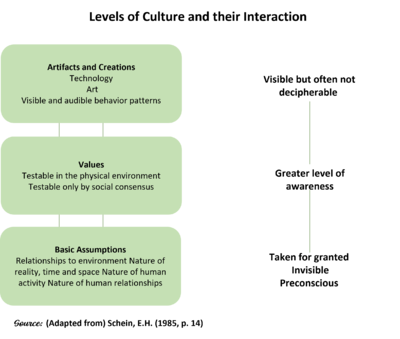Difference between revisions of "Culture Levels"
| Line 12: | Line 12: | ||
In his 1984 article 'Coming to a New Awareness of Organizational Culture', Schein defines Organizational culture as "the pattern of basic assumptions that a given group has invented, discovered, or developed in learning to cope with its problems of external adaptation and internal integration, and that has worked well enough to be considered valid, and, therefore, to be taught to new members as the correct way to perceive, think, and feel in relation to those problems." | In his 1984 article 'Coming to a New Awareness of Organizational Culture', Schein defines Organizational culture as "the pattern of basic assumptions that a given group has invented, discovered, or developed in learning to cope with its problems of external adaptation and internal integration, and that has worked well enough to be considered valid, and, therefore, to be taught to new members as the correct way to perceive, think, and feel in relation to those problems." | ||
| + | |||
| + | Schein's view of culture on these three levels has been described as “one of the only conceptual models ever offered” (Hatch, 1993, p. 658). Schein’s (1985) model of culture emphasizes distinguishable categories of organizational culture which have commonly become known as the three | ||
| + | components of organizational culture (Ott, 1989). Schein’s (1985) conceptualization of culture is shown in the Figure below. | ||
| + | |||
| + | |||
| + | [[File:Levels of Culture Interaction.png|400px|Levels of Culture and their Interaction]] | ||
Revision as of 13:46, 13 June 2022
As the continuation of successful action (Baecker, 1999), culture shows the materialized "information processing" of a social system. Culture provides the structure in which action is possible, and as such reduces complexity to a degree that is manageable for the system (Luhmann,1984; Baecker,1999). But structure is virtual (Giddens, 1984) and only becomes visible through social norms and actions.
According to Edgar Schein (2010, 2015), organizations consist of three levels of culture:
- Artifacts: The first level, artifacts, constitutes the visible structures and processes as well as observed behavior.
- Espoused Beliefs: The second level, espoused beliefs and values, includes amongst others ideals, ideologies and rationalizations.
- Values and Basic Underlying Assumptions: The third level, basic underlying assumptions, comprises of unconscious beliefs and values. This level is more difficult to analyze, but essential to understand the emergence of organizational culture: "In other words, the essence of a culture lies in the
pattern of basic underlying assumptions, and after you understand those, you can easily understand the other more surface levels and deal appropriately with them" (Schein, 2010, p. 32).
In his 1984 article 'Coming to a New Awareness of Organizational Culture', Schein defines Organizational culture as "the pattern of basic assumptions that a given group has invented, discovered, or developed in learning to cope with its problems of external adaptation and internal integration, and that has worked well enough to be considered valid, and, therefore, to be taught to new members as the correct way to perceive, think, and feel in relation to those problems."
Schein's view of culture on these three levels has been described as “one of the only conceptual models ever offered” (Hatch, 1993, p. 658). Schein’s (1985) model of culture emphasizes distinguishable categories of organizational culture which have commonly become known as the three components of organizational culture (Ott, 1989). Schein’s (1985) conceptualization of culture is shown in the Figure below.
See Also


